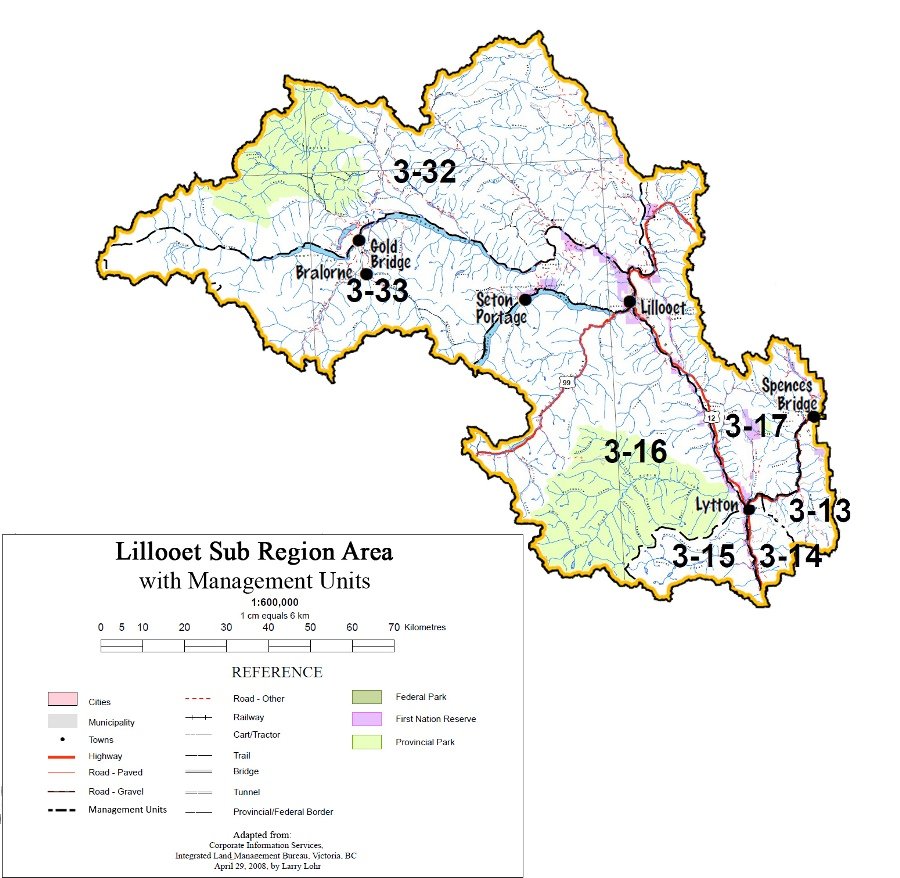Main Sections
Fish and Riparian Habitat
Fishing is important for commercial, sport, recreation, tourism and food purposes. Thirty-three species of fish have been identified in the plan area. Coho salmon, steelhead, bull trout (blue-listed) and white sturgeon (red-listed) populations are of special concern.
Riparian Habitat (habitat adjacent to a lake, stream or river, influenced by surface water) is vitally important for many species, particularly fish, amphibians, moose, grizzly bear and many birds. Riparian forests are also highly productive timber areas and are important to the agriculture industry.
This section addresses fish, in general, and riparian habitats. Management direction for bull trout and white sturgeon is included in the Species at Risk section.
Wetlands play an important role in climate change, economic systems, flood and erosion control and ecologically, holding food and wildlife habitat. In order to protect wetlands and streams there has to do be a development of comprehensible and reliable wetland information so that planning, law and policy elaboration can be undertaken effectively. This is done by developing baseline data on wetland location and improving cooperation between BC government agencies and provincial and federal governments. Scientific research groups can also estimate and compare the current and historical extent of wetlands in BC along with their types in order to help the improvement of wetland understanding and the threats that they encounter. Moreover, geographical identification and mapping of priority wetlands, and determining what makes one a priority over the other is a major concern.The public, industries and government should be more informed and that is why there is a lot of promotion and advertising to encourage the parties to learn more about wetlands and how to protect them. The implementations of laws have to be effective by looking into BC laws that can harm or preserve wetlands, and if possible improving them. Additionally, there is a need to find a policy or law model from other provinces or states that was successful in conservation that may be of aid when attempting to employ an ecosystem based management plan. There is also the promotion of the watershed management plan process that includes water planning and the development of tools for such a process. Developing new laws and policies should include wetland protection and conservation and this is checked by the BC Wetland Stewardship Partnership. There is a necessity in identifying priority wetlands and ensuring their protection, as well as restoring and protecting the ones that need to be around the province. In addition, a coordination and partnership development is essential for an improved effectiveness, as well as avoiding misunderstanding and doubling in plans or researches between different organizations.
Source: BC Wetland Action Plan
Wetlands are used against climate change, for landscape conservation and for filtering water. They have various roles in the natural cycles and are important to conserve and protect. A management plan was implemented in 2008, Living Water Smart. Wetlands and waterway functions are being assigned as protected areas and are being rehabilitated if need. The government will be providing encouragement in the form of funding to restore streams and/or wetlands. When possible, the government will also restore parts of streams and wetlands surrounding communities and cities. The restoration of wetlands for greenhouse effect storage will be greatly encouraged by the government. For landscape and flood management many local communities have taken it into their own hands to develop their own wetland management such as development free areas neighbouring fish-bearing wetlands. The creation of Development Permit Areas (DPA), as well as various wetland guidelines, zoning setbacks or tax incentives have also been established. Some localities are also in the process of developing watershed-based integrated stormwater and stream corridor management. Local schools have built wetlands near the schools to provide landscape management as well as having an outdoor classroom experience and educate students to the importance of wetlands in the ecosystem. Low Impact Development (LID) used in communities helps the conservation and protection of wetlands, as well as having on-site stormwater retention techniques like rain gardens, green roofs and living walls, permeable or porous pavements, bioswales, constructed wetlands and bioretention ponds.
Source: Wetland Primer In BC
Issues:
Need for better information on fish and the location and type of the habitat they use, particularly for bull trout and white sturgeon.
- Fish mortality and loss of fish habitat due to hydroelectric facilities and resource development activities.
- Summertime stream temperatures in the eastern part of the plan area may be too hot for fish.
- Some degraded fish habitats require restoration.
- Basic legal requirements may not conserve and protect riparian areas around small, fish-bearing streams and nonfish-bearing streams.
- Forest health management can lead to a loss of riparian vegetation.
Goals:
- Viable fish populations in naturally diverse habitats and healthy riparian areas
